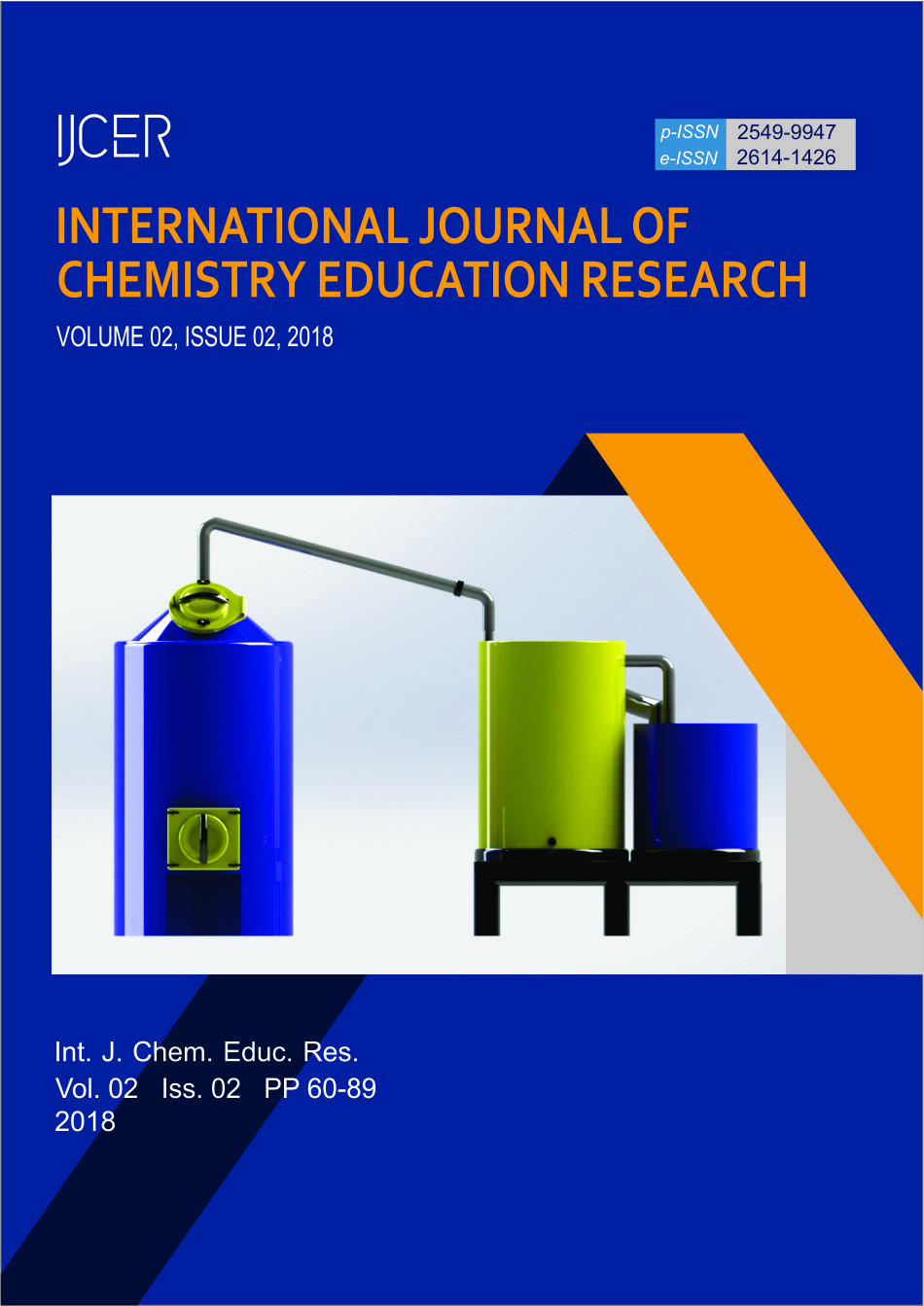Main Article Content
Abstract
This research produced a teaching material in the form Work Sheet (LKPD) based guided inquiry which involves 3 levels of chemical phenomena namely macroscopic, sub-microscopic and symbolic. The worksheet was created using Plomp model and using guided inquiry learning cycle consisting of orientation, exploration, concept formation, application, and closure. This LKPD has been tested validity, practicality, and effectiveness. The validity test gives the result of the kappa moment of 0.83 with the category of very high. Analysis of practicality in one-to-one, small group, and field test stage showed the value of 0.80, 0.76, and 0.70 with all three values in the high category. Effectiveness test seen from student’s learning outcome before and after using LKPD obtained gain score is 0.76 in the high category and average activity of students is 86.3% at every meeting. The results showed that, worksheet using the Plomp model which has been produced are valid, practical, and effective
Keywords: Guided inquiry, chemical bonding, validity, practicality, effectiveness
Article Details
Author retain copyright and grant the journal right of first publication with the simultaneously licenced under A Creative Commons Attribution (CC-By-SA) 4.0 License that allows others to share the work with an acknowledgment of the worsk's authorship and initial publication in this journal.
References
- R. Chang, General Chemistry: The Essential Concept Sixth Edition (Mc Graw Hill Higher Education, New York, 2011), pp.1.
- American Chemical Society, ACS Guidelines and Recommendation for the Theaching of High School Chemistry (American Chemical Society, Washington, 2012), pp. 10.
- G. Sirhan, Journal of TU SED. 4, 2, 2-20 (2007).
- G. Chittleborough, D. F. Treagust, Chemistry Education Research and Practice. 8, 3, 274-292 (2007).
- H. Özmen, Journal of TU SED. 13, 2, 147-159 (2004).
- G. Dwi yanti, A. Suryatna, I. Taba, Development of Guided Inquiry-Based Student Lab Worksheet on the Making of Pineapple Flavoring. DOI: 10.1088/1742-6596/812/1/012074, 1 (2017).
- S. Rahmiati, dan Mawardi., Proceedings of Academics World 28th International Conference (Tokyo, Japan, 28 th March, 2016). 65. ISBN 978-93- 85973-72-7
- I. Bilgin, Scientific Research and Essay. 4, 10, 1038-1046 (2009)
- Myers, Monypenny, Trevathan, JLD. 5, 1, 12-22 (2012)
- Plomp, and nieveen, Part A: Educational Design Research: An Introduction (Netherland Institute for Curriculum Development (SLO), Netherland, 2013), pp. 15.
- Boslaugh, Sarah dan Paul, Statistics in a Nutshell, a desktop quick reference (O’reilly, Beijing, Cambridge, Famham, Köln, Sebastopol, Taipei, Tokyo, 2008), pp. 13.
- Kunandar, Guru Profesional Implementasi Kurikulum Tingkat Satuan Pendidikan dan Sukses dalam Sertifikasi Guru (Raja Grafindo Persada, Jakarta, 2007).
- Hake, Relationship of Individual Student Normalized Learning Gains in Mechanics with Gender, High-School Physics, and Pretest Scores on Mathematics and Spatial Visualization. 3 (2002).
- Ridwan, Belajar Mudah Penelitian Untuk Guru-Karyawan dan Peneliti Pemula (Alfabeta, Bandung, 2009).
- Van den Akker, Jan, Design Approaches and Tools in Education and Training (Springer Science Business Media, B.V, Dordrecht, 1999), pp. 10.
- The College Board, AP® Chemistry Guided-Inquiry Experiments: Applying the Science Practices (Teacher Manual) (The College Board, New York, 2013), pp. 6.
References
R. Chang, General Chemistry: The Essential Concept Sixth Edition (Mc Graw Hill Higher Education, New York, 2011), pp.1.
American Chemical Society, ACS Guidelines and Recommendation for the Theaching of High School Chemistry (American Chemical Society, Washington, 2012), pp. 10.
G. Sirhan, Journal of TU SED. 4, 2, 2-20 (2007).
G. Chittleborough, D. F. Treagust, Chemistry Education Research and Practice. 8, 3, 274-292 (2007).
H. Özmen, Journal of TU SED. 13, 2, 147-159 (2004).
G. Dwi yanti, A. Suryatna, I. Taba, Development of Guided Inquiry-Based Student Lab Worksheet on the Making of Pineapple Flavoring. DOI: 10.1088/1742-6596/812/1/012074, 1 (2017).
S. Rahmiati, dan Mawardi., Proceedings of Academics World 28th International Conference (Tokyo, Japan, 28 th March, 2016). 65. ISBN 978-93- 85973-72-7
I. Bilgin, Scientific Research and Essay. 4, 10, 1038-1046 (2009)
Myers, Monypenny, Trevathan, JLD. 5, 1, 12-22 (2012)
Plomp, and nieveen, Part A: Educational Design Research: An Introduction (Netherland Institute for Curriculum Development (SLO), Netherland, 2013), pp. 15.
Boslaugh, Sarah dan Paul, Statistics in a Nutshell, a desktop quick reference (O’reilly, Beijing, Cambridge, Famham, Köln, Sebastopol, Taipei, Tokyo, 2008), pp. 13.
Kunandar, Guru Profesional Implementasi Kurikulum Tingkat Satuan Pendidikan dan Sukses dalam Sertifikasi Guru (Raja Grafindo Persada, Jakarta, 2007).
Hake, Relationship of Individual Student Normalized Learning Gains in Mechanics with Gender, High-School Physics, and Pretest Scores on Mathematics and Spatial Visualization. 3 (2002).
Ridwan, Belajar Mudah Penelitian Untuk Guru-Karyawan dan Peneliti Pemula (Alfabeta, Bandung, 2009).
Van den Akker, Jan, Design Approaches and Tools in Education and Training (Springer Science Business Media, B.V, Dordrecht, 1999), pp. 10.
The College Board, AP® Chemistry Guided-Inquiry Experiments: Applying the Science Practices (Teacher Manual) (The College Board, New York, 2013), pp. 6.




